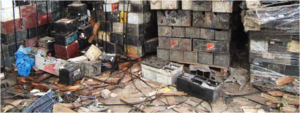It has been three years of tense litigation between El Salvador’s Attorney General’s office and the Grupo Record lead-acid battery facility since Blacksmith Institute’s first visit in 2008. After his meeting with Herman Rosa Chavez, Salvadorian Minister of the Environment, it looks like there is finally potential for clean up of the surrounding area, reported Program Officer Bret Ericson, who just returned from the Central American country.

“Blacksmith may design the environmental cleanup plan and oversee its implementation,” he said, providing valuable technical support impacting the lives of nearly a thousand people at risk and with many complaints of throat discomfort, runny eyes and insomnia caused by bad air quality.

The Blacksmith visit was held jointly with international and local representatives of the Basel Secretariat, which oversees the transboundary movement of hazardous waste, including Blacksmith Technical Advisor Brian Wilson, who also serves on the International Lead Management Council.

About 15 miles northwest of the capital city, San Salvador, the Grupo Record facility was closed abruptly on September 23, 2007, for contaminating surrounding soil and air with lead, which showed up in the blood tests of area residents. The nearest community was only 500 feet away with others to the west and south. While enclosed, air flowed freely through large openings and doors, and the flat surrounding terrain provided no cover to contain air contaminants from plant chimneys, slag piles and lead materials.
Grupo Record had been recycling lead-acid batteries there since 1994, approximately 30,000 batteries a month, recovering plastic casings and smelting lead into ingots in four rotary kiln furnaces. According to the company, environmental upgrading had been underway for seven years, but the decision had been made to cease operations that December despite improvements. The Salvadorean Ministry of Health intervened instead, prompted by extensive community protests, including a march from the factory site to government offices by a thousand residents demanding action as well as by dangerous blood testing results that had been made possible by the US Environmental Protection Agency.

Owners and workers were jailed. Operators were given only two hours to shut down furnaces, when the minimum time for decommissioning usually would have been four days. This sudden abandonment exacerbated subsequent contamination problems.
A few months later, Blacksmith’s tour of the facility, while encircled by a restrictive cinderblock/barbed wire fence, showed dust everywhere…on leaves and trees on the seven-plus acre site. Debris was found throughout the main factory floor–open batteries exposed to the elements, dozens of bags of coal/carbon, calcium hydroxide and other reactants. There were also failing waste containment units which require constant maintenance for effectiveness. 1,500 tons of materials had been left behind.

While there now is no smelting nor gaseous emissions from the plant, substantial fine particles continuously are airborne and redeposited elsewhere in the plant and its surroundings. When inhaled, they are deposited in the upper respiratory track of area residents and subsequently absorbed in the circulatory system and entire body. This is what Blacksmith Institute hopes to remedy with support from the Salvadorean Ministry of the Environment.






